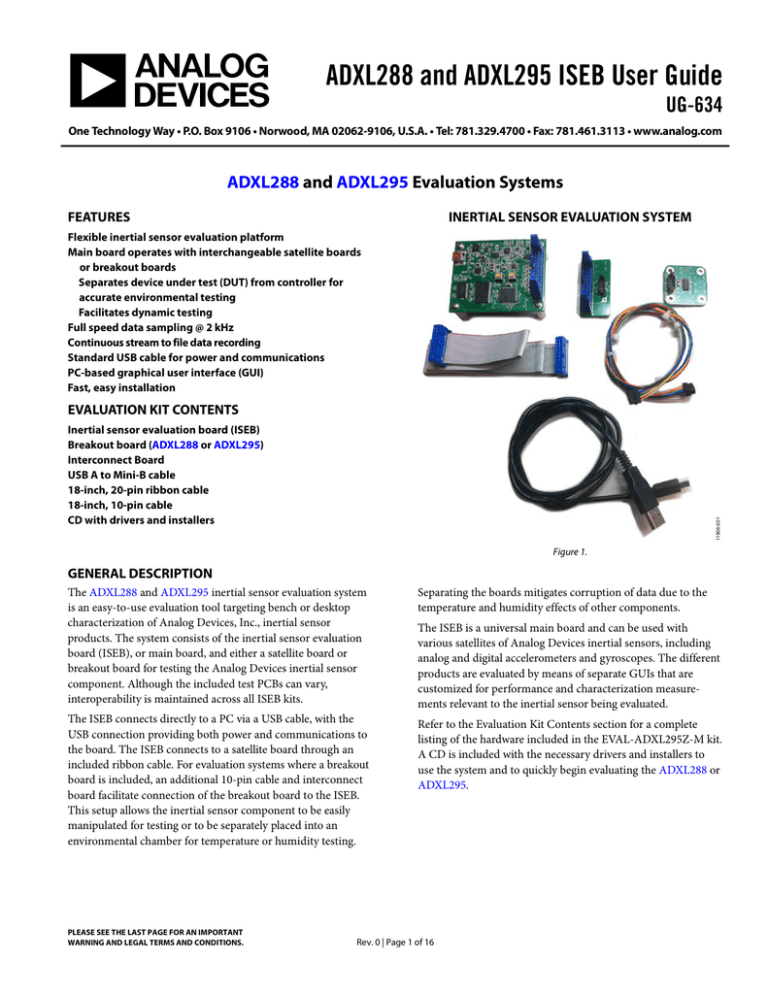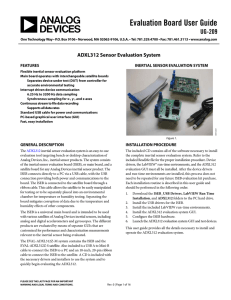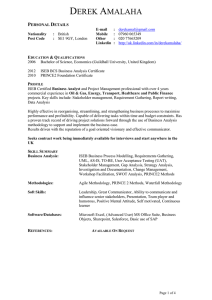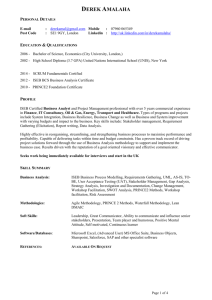ADXL288 and ADXL295 ISEB User Guide UG-634
advertisement

ADXL288 and ADXL295 ISEB User Guide UG-634 One Technology Way • P.O. Box 9106 • Norwood, MA 02062-9106, U.S.A. • Tel: 781.329.4700 • Fax: 781.461.3113 • www.analog.com ADXL288 and ADXL295 Evaluation Systems FEATURES INERTIAL SENSOR EVALUATION SYSTEM Flexible inertial sensor evaluation platform Main board operates with interchangeable satellite boards or breakout boards Separates device under test (DUT) from controller for accurate environmental testing Facilitates dynamic testing Full speed data sampling @ 2 kHz Continuous stream to file data recording Standard USB cable for power and communications PC-based graphical user interface (GUI) Fast, easy installation EVALUATION KIT CONTENTS 11906-001 Inertial sensor evaluation board (ISEB) Breakout board (ADXL288 or ADXL295) Interconnect Board USB A to Mini-B cable 18-inch, 20-pin ribbon cable 18-inch, 10-pin cable CD with drivers and installers Figure 1. GENERAL DESCRIPTION The ADXL288 and ADXL295 inertial sensor evaluation system is an easy-to-use evaluation tool targeting bench or desktop characterization of Analog Devices, Inc., inertial sensor products. The system consists of the inertial sensor evaluation board (ISEB), or main board, and either a satellite board or breakout board for testing the Analog Devices inertial sensor component. Although the included test PCBs can vary, interoperability is maintained across all ISEB kits. The ISEB connects directly to a PC via a USB cable, with the USB connection providing both power and communications to the board. The ISEB connects to a satellite board through an included ribbon cable. For evaluation systems where a breakout board is included, an additional 10-pin cable and interconnect board facilitate connection of the breakout board to the ISEB. This setup allows the inertial sensor component to be easily manipulated for testing or to be separately placed into an environmental chamber for temperature or humidity testing. PLEASE SEE THE LAST PAGE FOR AN IMPORTANT WARNING AND LEGAL TERMS AND CONDITIONS. Separating the boards mitigates corruption of data due to the temperature and humidity effects of other components. The ISEB is a universal main board and can be used with various satellites of Analog Devices inertial sensors, including analog and digital accelerometers and gyroscopes. The different products are evaluated by means of separate GUIs that are customized for performance and characterization measurements relevant to the inertial sensor being evaluated. Refer to the Evaluation Kit Contents section for a complete listing of the hardware included in the EVAL-ADXL295Z-M kit. A CD is included with the necessary drivers and installers to use the system and to quickly begin evaluating the ADXL288 or ADXL295. Rev. 0 | Page 1 of 16 UG-634 ADXL288 and ADXL295 ISEB User Guide TABLE OF CONTENTS Features .............................................................................................. 1 How to Use the Inertial Sensor Evaluation System GUI ..............9 Evaluation Kit Contents ................................................................... 1 Getting Started ...............................................................................9 Inertial Sensor Evaluation System .................................................. 1 Configuration Tab (Phase 3)..................................................... 10 General Description ......................................................................... 1 View/Record Data (Phase 4) ..................................................... 12 Revision History ............................................................................... 2 Arming Pin Functional Test (Phase 4) ....................................... 13 Getting Started .................................................................................. 3 Temperature Test Panel (Phase 4) ............................................ 14 Installation Procedure .................................................................. 3 Troubleshooting Tips ..................................................................... 15 Inertial Sensor Evaluation System Setup ................................... 3 Header Pinout ................................................................................. 16 Evaluation Board Hardware ............................................................ 8 Related Links ................................................................................... 16 Hardware Configuration ............................................................. 8 REVISION HISTORY 3/14—Revision 0: Initial Version Rev. 0 | Page 2 of 16 ADXL288 and ADXL295 ISEB User Guide UG-634 GETTING STARTED INSTALLATION PROCEDURE Installing the USB Drivers for the ISEB The included CD contains all of the software necessary to install the complete inertial sensor evaluation system. Refer to the included ReadMe file for the proper installation procedure. Device drivers, LabVIEW® run-time environments, and the ADXL288 and ADXL295 evaluation GUI must all be installed. After the device drivers and run-time environments are installed, this process does not need to be repeated for any future ISEB evaluation kit purchase. To install the USB drivers, take the following steps: Each installation routine is described in this user guide and should be performed in the following order. 1. 2. 3. 4. 5. 6. Download the USB Drivers, LabVIEW Run Time Installation, and ADXL288 - ADXL295 folders to the PC hard drive. (See the Download Files section.) Install the USB drivers for the ISEB. (See the ISEB Hardware Setup section.) Install the included LabVIEW run-time environment. (See the Installing the LabVIEW Run Time Environment section.) Install the ADXL288 and ADXL295 evaluation system GUI. (See the ADXL288 and ADXL295 Software Evaluation GUI section.) Configure the ISEB hardware. (See the Hardware Configuration section.) Launch the ADXL288 and ADXL295 evaluation system GUI and test devices. (See the How to Use the Inertial Sensor Evaluation System GUI section.) 1. 2. 3. Execute the ADI_ISEB_USB_Drivers.exe file located in USB Drivers. Follow the on-screen instructions to install the drivers. Click Continue Anyway when prompted that the drivers are not tested. Next, connect the ISEB main board to the computer via the included USB cable. If the previously installed drivers are not automatically associated with the device, select the drivers manually, as follows: 1. 2. Connect the USB A to Mini-B cable to the PC and then to the ISEB. When the ISEB board is connected, the Found New Hardware Wizard window appears. If prompted to install drivers, click Install from a list or specific location (Advanced) and click Next (see Figure 2). This user guide provides all the details necessary to install and operate the ADXL288 and ADXL295 evaluation system. 11906-002 INERTIAL SENSOR EVALUATION SYSTEM SETUP Download Files Before proceeding with the installation routine, download the ADXL288 - ADXL295, USB Drivers, and LabVIEW Run Time Installation folders (located on the included CD) to a local folder on the target PC. This can be completed as follows: 1. 2. 3. Figure 2. Found New Hardware Prompt 3. Select Don’t search. I will choose the driver to install and click Next (see Figure 3). Browse to a destination directory on the host PC. Right-click to select New > Folder. Name this folder and copy the CD files into this new location. ISEB Hardware Setup 11906-003 Before connecting the ISEB hardware to the PC, drivers must be installed so that the PC properly recognizes the ISEB main board. The USB drivers for the ISEB are available in the USB Drivers folder. Figure 3. Selection of the Driver to Install Rev. 0 | Page 3 of 16 UG-634 Select ADI Inertial Sensor Evaluation System from the model list and click Next to complete the process (see Figure 4). 11906-005 4. ADXL288 and ADXL295 ISEB User Guide 11906-004 Figure 5. Computer Properties Figure 4. Selection of the ADI Inertial Sensor Evaluation System Drivers The ISEB should be detected automatically in the Device Manager as ADI Inertial Sensor Evaluation System under the Ports (COM & LPT) selection. It is recommended to open the Device Manager to verify hardware detection and to record the communication port associated with the ISEB for use in the GUI. COM Port Verification Installing different firmware revisions, as well as operating the ADXL288 and ADXL295 evaluation GUI, requires that the user know the COM port that is assigned to the ISEB main board. With the ISEB main board connected to the PC, perform the following steps to determine the assigned COM port number. 1. 2. 3. 4. From the Start menu, right-click Computer and select Properties. The window shown in Figure 5 opens. Underneath Tasks, select Device Manager. Windows Vista may request that the user allow access to this panel, and administrative privileges may also be required. The window shown in Figure 6 opens. Expand the Ports (COM & LTP) folder. The ADI Inertial Sensor Evaluation System should be listed with an assigned COM port number in parenthesis. Note the COM port number for future use. Rev. 0 | Page 4 of 16 11906-006 For Windows® Vista/7, Figure 6. Device Manager Showing the COM Port Number ADXL288 and ADXL295 ISEB User Guide UG-634 For Windows XP/2000, 1. 2. 11906-008 3. From the Start menu, right-click My Computer and select Properties. Click the Hardware tab of the System Properties window (see Figure 7). Click Device Manager to look up the assigned COM port of the ISEB hardware. The Device Manager window should look like the window shown in Figure 6. Figure 8. ISEB ARMWSD Firmware Downloader 3. 4. Click Browse and select the firmware associated with the desired product. Each firmware file is named according to the products that it supports. Click Configure to display the window shown in Figure 9. 11906-007 Configure the downloader file for the ADuC7026 microcontroller. The only option that may need adjusting is the COM port. The user can select the correct port from the Serial Port box on the Comms tab (see Figure 9). Figure 7. System Properties Installing Other ISEB Firmware Revisions The ADI_ISEB_FW_XL288_XL295.hex file should already be installed on the ISEB main board. To flash the ISEB microcontroller with new firmware, follow these steps: 1. 2. Ensure that the ISEB is connected to and detected by the PC. The COM port on which the device is recognized must also be known, as mentioned in the COM Port Verification section. Run the ARMWSD.exe program located in the Firmware Utility folder; it displays information about the downloader, see Figure 8. Rev. 0 | Page 5 of 16 11906-009 The ISEB evaluation system is designed to allow maximum flexibility for the user. Interchangeable satellite and breakout boards are designed to operate with the same ISEB main board. When transitioning between satellite/breakout boards, it may be necessary to install a different firmware revision onto the main board. A utility has been included to allow for quick and easy flashing of the appropriate firmware, and the latest firmware revisions are included on the installation CD, located in the Firmware Utility folder. Figure 9. Selecting the Correct COM Port for the Downloader UG-634 ADXL288 and ADXL295 ISEB User Guide When the COM port is selected, click OK to accept the changes and go back to the ARMWSD window (see Figure 8). The downloader is now fully configured. Follow these steps to flash the firmware: 1. 2. 3. Click Start in the ARMWSD box (see Figure 8) to initiate the flashing process. Press the two buttons (shown in Figure 10) on the ISEB in the following order to flash the firmware: a. Press and hold down SW1. b. With SW1 held down, press and release SW2. c. Release SW1. The download begins and is automatically verified by the downloader. Installing the LabVIEW Run Time Environment Located in the LabVIEW Run Time Installation folder on the CD is an executable file designed to install the LabVIEW environment packages required for operation of the various product GUIs. To begin the installation process, double-click the LabVIEW Run Time Install.exe file (see Figure 11). Follow the on-screen prompts to successfully install the necessary LabVIEW components. SW1 11906-010 ADuC7026 SW2 4. 5. If the downloading process fails, which is indicated in the Monitor Status window (see Figure 8), attempt the download again by repeating Step 1 through Step 3. After the download has completed successfully, click Run (shown in Figure 8). The ADI_ISEB_FW_XL288_XL295.hex firmware has been developed for specific operation with the ADXL288 or ADXL295 satellite board. To use the ISEB main board with any other satellite board, simply locate the other device’s firmware on the included installation CD and flash it onto the ISEB main board. This allows operation with that device’s evaluation GUI. Rev. 0 | Page 6 of 16 11906-011 Figure 10. ISEB Switch Locations for Flashing the Microcontroller Figure 11. LabVIEW Run Time Environments Installation ADXL288 and ADXL295 ISEB User Guide UG-634 ADXL288 and ADXL295 Software Evaluation GUI To run the software GUI installation, double-click the setup.exe file located in the ADXL288 - ADXL295 > Software folder on the included CD. The window shown in Figure 12 appears. Complete the following steps to install the evaluation software: 3. Figure 13. Destination Directory Selection 11906-012 4. 5. 11906-013 2. Select the Destination Directory (see Figure 13). It is recommended to keep the default settings for these fields. Click Next. The License Agreement window then appears/opens. Read the National Instruments Software License Agreement. Choose I accept the License Agreement(s), and then click Next. The installer then lists the required components to be installed on the PC (see Figure 14). Click Next to start the installation. Click Finish to complete the installation. 11906-014 1. Figure 12. ADXL288 and ADXL295 Evaluation Software Installation Welcome Figure 14. Start Installation (Listing Varies Based on PC Requirements) Rev. 0 | Page 7 of 16 UG-634 ADXL288 and ADXL295 ISEB User Guide EVALUATION BOARD HARDWARE HARDWARE CONFIGURATION Connect the ADXL288 and ADXL295 evaluation system as demonstrated in Figure 15. The USB A to Mini-B cable is used to connect the ISEB motherboard to a Windows®-based PC. The 20-pin ribbon cable connects the ISEB motherboard to the included interconnect board. The interconnect board takes the necessary I/Os from the 20-pin ribbon cable and passes a subset of them to the included ADXL288 or ADXL295 breakout board. All of the included cables are keyed such that improper connection of the boards is avoided. To ensure that the ADXL288 and ADXL295 evaluation system is properly enabled, the following process is recommended: 1. 2. 3. 4. 11906-015 5. Ensure that the ADI_ISEB_FW_XL288_XL295.hex firmware file has been previously loaded onto the ISEB motherboard. This process should be completed without the ADXL288 or ADXL295 breakout board attached. Connect the ADXL288 or ADXL295 breakout board to the adaptor board with the included 10-pin cable. Connect the adaptor board to the ISEB motherboard with the included 20-pin ribbon cable. Connect the ISEB main board to a Windows-based PC with the included USB A to Mini-B cable. After observing the green LED on the ISEB motherboard turn on, launch the ADXL288_ ADXL295_Eval GUI from the Start menu. Figure 15. ISEB Kit Connections Rev. 0 | Page 8 of 16 ADXL288 and ADXL295 ISEB User Guide UG-634 HOW TO USE THE INERTIAL SENSOR EVALUATION SYSTEM GUI GETTING STARTED As part of the installation routine, a Start menu item is created that launches the ADXL288 and ADXL295 Evaluation GUI. Click the executable, located at Start > All Programs > Analog Devices – Inertial Sensor Eval > ADXL288 - ADXL295 Evaluation Software > ADXL288_ADXL295 Eval. 1. 2. 3. From the drop-down menu, select the device type that corresponds to the DUT mounted on the breakout board. Select the COM port assigned to the ISEB evaluation board. Refer to the COM Port Verification section for the procedure to verify the COM port assignment. Ensure that a reasonable COM port value (<10) has been assigned to the ISEB hardware. The software does not interact properly with excessively high COM port values. 11906-016 When opened, you will see the window shown in Figure 16. All functionality is disabled until the correct device type and COM port selection is complete. As the SPI format is different for the ADXL288 and ADXL195/ADXL295 devices, it is important to select the correct device type to ensure proper operation. To do so, use the following instructions: Figure 16. COM Port Selection Rev. 0 | Page 9 of 16 UG-634 ADXL288 and ADXL295 ISEB User Guide CONFIGURATION TAB (PHASE 3) pin (ARM_X or ARM_Y) will assert. For more information, refer to the ADXL288 or ADXL295 data sheet. When the ADXL288 or ADXL295 device is first powered on, it will not immediately proceed into run-time operation. The device proceeds through its start-up sequence, remaining in Phase 3 until the end of initialization command is provided by the master device. When viewing acceleration data in the Configure Device tab, if the ARM_X or ARM_Y pin is observed to assert either positively or negatively, the LED indicators will turn-on. During Phase 3, the following actions are available in the Configure Device tab: • • • The arming thresholds can be set. The auto zero configuration can be adjusted. The electromechanical self test can be activated, such that the acceleration output delta can be measured. Figure 18. Arming Pin Configurations Self Test Enable Phase 3 represents the only opportunity for activating the electromechanical self test. Activating this feature induces an electrostatic force onto the mechanical structure, resulting in a dc deflection of the movable sense element. The offset delta, pre and post self test activation, indicates the success of the self test routine. To activate self test, check the appropriate box in the Self Test Enable control box (see Figure 19). This enables the device self test, and the memory map updates to reflect this status change. Then, press the View XL/HF Data button in the XL/HF Channel Self Test Values and Auto Zero control box. 11906-019 Upon selecting the device type, the pop-up window will close, and you will be presented with the screen shown in Figure 17. An initial read of all device registers is performed at this point, populating the register memory map shown at the right side of the GUI window. The memory map should look similar to the contents presented in Figure 17; however, there will be noticeable differences due to device variations, such as different serial numbers or revision IDs. Memory Address 0x08 can be used to verify a correct read of the memory map. For a single-axis device (ADXL195), Register 0x08 reads 0x1C. For a dual-axis device (ADXL288 and ADXL295), Register 0x08 reads 0x2C. 11906-018 Once the device enters Phase 4, these settings can no longer be configured. However, the device can be returned to Phase 3 at any time by issuing a soft reset command. All of this functionality is readily available through the ADXL288 and ADXL295 evaluation GUI. Figure 19. Self Test Control 11906-017 SELF TEST ON SELF TEST OFF Figure 17. Configuration Panel Initial Conditions All variants of the ADXL288 and ADXL295 devices allow you to configure the arming thresholds (see Figure 18). If, internal to the ADXL288 or ADXL295 device, an acceleration data point exceeds the specified arming threshold, the associated arming Rev. 0 | Page 10 of 16 11906-020 Arming Threshold Configuration Figure 20. Acceleration Data with Self Test Off and On ADXL288 and ADXL295 ISEB User Guide UG-634 Auto Zero During Phase 3, the auto zero functionality can be switched between fast and slow auto zero (see Figure 21). This allows you to understand the differences between the two routines, and the speed with which they correct for offset. The auto zero functionality can also be disabled entirely. To set the mode of auto zero, simply select either the FAST or SLOW option from the radio button menu, and press the SET button. The next time the View XL/HF Data button is pressed, the data presented will conform to the selected auto zero mode. 11906-021 When the End of Initialization command is issued, and the device transitions to Phase 4, the auto zero mode will be automatically configured to slow auto zero. If auto zero was disabled during Phase 3, it will remain disabled during Phase 4. Figure 21. Auto Zero Enable/Disable To properly view the device self test response, use the following method: 1. 2. 3. 4. 5. Press View XL/HF Data. Press Stop Data View. Enable either the XL channel or HF channel self test (they cannot be activated simultaneously). Press View XL/HF Data. Press Stop Data View to capture the self test delta in the waveform graph window. Figure 22. Self Test Behavior End Of Initialization Once the desired settings have been configured, the end of initialization command can be issued to the device to lock in the chosen settings, and proceed to Phase 4. Press the End of Initialization button, and the GUI will transition the device into Phase 4 (see Figure 23). At this point, the functionality of the View/Record Data, Arming Pin Functional Test, and Temperature Test tabs will become available. This results in the behavior shown in Figure 22. The self test delta can now be measured and compared to the X, Y, or HF self test expected value. These values are stored in Register 0x0E, Register 0x0F, and Register 0x10 for the X, Y, and HF channels, respectively. For convenience, these values are also presented in the numeric indicator boxes in between the XL and HF channel waveform graphs. Rev. 0 | Page 11 of 16 11906-023 While Phase 3 is not the primary phase for viewing acceleration data, the Configure Device tab does allow limited capability in this regard. Press the View XL/HF Data button to see the HF channel and acceleration channel data output to their respective waveform graphs. 11906-022 View XL/HF Data Figure 23. End Of Initialization UG-634 ADXL288 and ADXL295 ISEB User Guide VIEW/RECORD DATA (PHASE 4) View XL and HF Channel Data The View/Record Data tab is one of the tabs for reading/ recording data from the ADXL288 or ADXL295 device. While you can return to the Configure Device tab at any time to perform a read of the memory registers, you will not be able to alter any of the device settings unless you press the RESET button, found in the lower left corner of any of the Phase 4 tabs. This option is presented for ADXL195 and ADXL295 devices. The functionality is exactly the same as in the View XL Channel Data section; however, this option includes the HF channel data. Once in Phase 4, the auto zero will be configured to slow mode (unless it was disabled), self test will be disabled, and the arming thresholds will be frozen based on their values during Phase 3. Before any action is taken, the evaluation GUI should resemble the image shown in Figure 24. Record XL Channel Data This option is presented for ADXL288 devices. This option performs a stream to file of all data presented in the front panel. This includes the acceleration data, SPI message header bits, X and Y auto zero offset value, and the status register. Data is written to file continuously, until the Stop Data View button is pressed. As the data rate is approximately 2 kHz, be careful to limit the data record time, or the data file may become unmanageably large. Record XL and HF Channel Data This option is presented for the ADXL195 or ADXL295 device. All of the same information, as described in the Record XL Channel Data section, is streamed to a data file, with the addition of the HF channel and associated SPI message bits. 11906-024 When selecting either of the record options shown in the Record XL Channel Data and Record XL and HF Channel Data sections, you will be presented with a file dialog, which allows you to create a new file, or overwrite an existing file. To ensure proper file format, the *.txt file extension should be written onto the file name manually (see Figure 26). The drop-down menu located on the left side of the GUI is the primary method for controlling the data view and record operations. The options will change depending upon the device type which was initially selected (ADXL288, ADXL195, or ADXL295). The following four sections show all options. View XL Channel Data Figure 26. Create or Overwrite File Dialog If you decide to cancel the data record at this point, the following message will be presented: 11906-027 This option is presented for ADXL288 devices. When selected, the XL channel data is collected and displayed on the waveform graph. The SPI message header bits are presented to the right of the waveform graph (see Figure 25). Lastly, a status register read is performed with every acceleration read, and the results are presented in the LED indicator array, at the left side of the GUI. 11906-026 Figure 24. View/Record Data Panel Figure 27. Record Data Cancel 11906-025 Upon confirming the file dialog, the View/Record Data tab will revert to its initial conditions, and you can continue to use the GUI without interruption. Figure 25. View XL Channel Data Rev. 0 | Page 12 of 16 ADXL288 and ADXL295 ISEB User Guide ARMING PIN FUNCTIONAL TEST (PHASE 4) UG-634 When the View All button is pressed, the XL channel, HF channel, if appropriate, and arming pin outputs are plotted simultaneously. Figure 29 shows an example where the positive and negative arming thresholds have been set to a low value of 1 g. This allows the thresholds to be exceeded by a simple shake of the device, resulting in the arming pin to assert both positively and negatively, in line with the acceleration data. 11906-029 As mentioned previously, ADXL288 and ADXL295 devices have two separate arming pins which can be used to alert the master device when the acceleration data exceeds a specified threshold. The value of these thresholds can be set independently for each axis, as well as independently for positive and negative acceleration. Upon initial entry to the Arming Pin Functional Test tab, you should see the screen shown in Figure 28. XL channel data will be presented in the top graph, HF channel data presented in the middle graph, and the state of the arming pin(s) presented in the lower graph. 11906-028 Figure 29. Arming Pin Output Figure 28. Arming Pin Functional Test Panel If the arming thresholds are not configured, that is, set to 0 g, then the default value of the arming pins will be 0 V (GND). Once an arming threshold is set, the behavior of the arming pin will change, such that the nominal value is now VDD/2. If the acceleration is measured to exceed the positive arming threshold, then the arming pin output changes from VDD/2 to 0.95 × VDD. If the negative arming threshold is exceeded, the arming pin output changes from VDD/2 to 0.05 × VDD. The arming pin does not latch for any longer than is required to analyze a subsequent acceleration data point (62.5 µs). Recording data is functionally identical to the View/Record Data tab. Upon pressing the Record All button, a file dialog will be presented (see Figure 26), and if you decide to cancel this procedure, a confirmation message will be presented as shown in Figure 27. All data presented in the front tab (XL channel, HF channel, arming pin outputs, and the status register) will be streamed to a file at the same data rate which they are presented on the screen. Rev. 0 | Page 13 of 16 UG-634 ADXL288 and ADXL295 ISEB User Guide TEMPERATURE TEST PANEL (PHASE 4) As part of most sensor evaluations, it is desired to know the offset drift characteristic over temperature. As this style testing typically takes an hour or more, the 2 kHz data rate of the other test tabs will aggregate too much data to be manageable by most software tools. The Temperature Test tab is designed to significantly reduce the bandwidth and data rate of the ADXL288 or ADXL295 device through oversampling and averaging. For this panel, a 2 kHz sample rate is used to retrieve data from the device; however, each data point placed on the graph is an average of 400 samples. This results in an output data rate of roughly 5 Hz. The status register is read with every XL channel and HF channel data read. To indicate whether a failure has occurred at any time over the course of sampling those 400 data points, the status register is continuously OR’d with every new data read. Therefore, although the status register is only updated at 5 Hz, it will indicate any and all errors which were observed over the entire 400 sample averaging period. 11906-030 Figure 30 shows the Temperature Test tab, as it is first presented. Both the XL channel and HF channel are represented on this tab. Additionally, the auto zero offset for each axis is presented. Therefore, even if the auto zero routine is enabled, you can still understand the performance of the offset by monitoring the auto zero offset value. Figure 30. Temperature Test Panel Again, data recording is functionally equivalent to the other test panels. Upon pressing the Record All button, a file dialog will be presented (see Figure 26), and if you decide to cancel this procedure a confirmation message will be presented as shown in Figure 27. All data presented in the front panel (XL channel, HF channel, auto zero values and the status register) will be streamed to a file at the same data rate which they are presented on the screen. Rev. 0 | Page 14 of 16 ADXL288 and ADXL295 ISEB User Guide UG-634 TROUBLESHOOTING TIPS The following tips are helpful for ensuring proper operation of the ISEB evaluation system, as well as recovery from any potential software/hardware errors. • • • • Connect the ISEB to the PC in this order: 1. Connect the satellite board to the main board (ribbon cable). 2. Connect the main board to the PC (USB cable). 3. Start the evaluation GUI on the PC by clicking: Start > All Programs > Analog Devices – Inertial Sensor Eval > ADXL288 - ADXL295 Evaluation Software > ADXL288_ADXL295 Eval. Make sure that the proper firmware is loaded onto the microcontroller (the software may appear to freeze if this step has not been completed). ADI_ISEB_FW_XL288_XL295.hex is required for proper operation of this evaluation system. • Rev. 0 | Page 15 of 16 Only press the reset button (SW2) when new firmware is being flashed onto the microcontroller. There is no other intended use for this button. Ensure that a low COM port number (<10) has been assigned to the ISEB. The software does not properly recognize excessively high COM port values. To properly reset the evaluation system, take the following steps: 1. Exit the ADXL288 and ADXL295 evaluation software. 2. Disconnect the ISEB (unplug the USB cable from the PC). 3. Reconnect the ISEB. 4. Restart the ADXL288 and ADXL295 evaluation software. UG-634 ADXL288 and ADXL295 ISEB User Guide HEADER PINOUT 3.3V CS2 P1 VS2 VS1 ST1 ST2 SCL1 SDA1 CLK 1 2 3 4 5 6 7 8 9 10 11 12 13 14 15 16 17 18 19 20 MOSI MISO CS3 CS4 S1 S2 S3 S4 CS2 VS2 VS1 ST1 ST2 SCL1 SDA1 CLK MOSI MISO CS3 CS4 GND 11906-031 AGND Figure 31. ISEB 20-Pin Header Pinout RELATED LINKS Resource ADXL288 ADXL295 ADXL195 ADuC7026 Description Product Page, High Performance, Dual-Axis Digital Output Accelerometer Product Page, Dual-Axis High Performance Accelerometer with Dual Spectrum Signal Processing Product Page, Single-Axis High Performance Accelerometer with Dual Spectrum Signal Processing Product Page, Precision Analog Microcontroller, 12-Bit Analog I/O ARM7 TDMI MCU ESD Caution ESD (electrostatic discharge) sensitive device. Charged devices and circuit boards can discharge without detection. Although this product features patented or proprietary protection circuitry, damage may occur on devices subjected to high energy ESD. Therefore, proper ESD precautions should be taken to avoid performance degradation or loss of functionality. Legal Terms and Conditions By using the evaluation board discussed herein (together with any tools, components documentation or support materials, the “Evaluation Board”), you are agreeing to be bound by the terms and conditions set forth below (“Agreement”) unless you have purchased the Evaluation Board, in which case the Analog Devices Standard Terms and Conditions of Sale shall govern. Do not use the Evaluation Board until you have read and agreed to the Agreement. Your use of the Evaluation Board shall signify your acceptance of the Agreement. This Agreement is made by and between you (“Customer”) and Analog Devices, Inc. (“ADI”), with its principal place of business at One Technology Way, Norwood, MA 02062, USA. Subject to the terms and conditions of the Agreement, ADI hereby grants to Customer a free, limited, personal, temporary, non-exclusive, non-sublicensable, non-transferable license to use the Evaluation Board FOR EVALUATION PURPOSES ONLY. Customer understands and agrees that the Evaluation Board is provided for the sole and exclusive purpose referenced above, and agrees not to use the Evaluation Board for any other purpose. Furthermore, the license granted is expressly made subject to the following additional limitations: Customer shall not (i) rent, lease, display, sell, transfer, assign, sublicense, or distribute the Evaluation Board; and (ii) permit any Third Party to access the Evaluation Board. As used herein, the term “Third Party” includes any entity other than ADI, Customer, their employees, affiliates and in-house consultants. The Evaluation Board is NOT sold to Customer; all rights not expressly granted herein, including ownership of the Evaluation Board, are reserved by ADI. CONFIDENTIALITY. This Agreement and the Evaluation Board shall all be considered the confidential and proprietary information of ADI. Customer may not disclose or transfer any portion of the Evaluation Board to any other party for any reason. Upon discontinuation of use of the Evaluation Board or termination of this Agreement, Customer agrees to promptly return the Evaluation Board to ADI. ADDITIONAL RESTRICTIONS. Customer may not disassemble, decompile or reverse engineer chips on the Evaluation Board. Customer shall inform ADI of any occurred damages or any modifications or alterations it makes to the Evaluation Board, including but not limited to soldering or any other activity that affects the material content of the Evaluation Board. Modifications to the Evaluation Board must comply with applicable law, including but not limited to the RoHS Directive. TERMINATION. ADI may terminate this Agreement at any time upon giving written notice to Customer. Customer agrees to return to ADI the Evaluation Board at that time. LIMITATION OF LIABILITY. THE EVALUATION BOARD PROVIDED HEREUNDER IS PROVIDED “AS IS” AND ADI MAKES NO WARRANTIES OR REPRESENTATIONS OF ANY KIND WITH RESPECT TO IT. ADI SPECIFICALLY DISCLAIMS ANY REPRESENTATIONS, ENDORSEMENTS, GUARANTEES, OR WARRANTIES, EXPRESS OR IMPLIED, RELATED TO THE EVALUATION BOARD INCLUDING, BUT NOT LIMITED TO, THE IMPLIED WARRANTY OF MERCHANTABILITY, TITLE, FITNESS FOR A PARTICULAR PURPOSE OR NONINFRINGEMENT OF INTELLECTUAL PROPERTY RIGHTS. IN NO EVENT WILL ADI AND ITS LICENSORS BE LIABLE FOR ANY INCIDENTAL, SPECIAL, INDIRECT, OR CONSEQUENTIAL DAMAGES RESULTING FROM CUSTOMER’S POSSESSION OR USE OF THE EVALUATION BOARD, INCLUDING BUT NOT LIMITED TO LOST PROFITS, DELAY COSTS, LABOR COSTS OR LOSS OF GOODWILL. ADI’S TOTAL LIABILITY FROM ANY AND ALL CAUSES SHALL BE LIMITED TO THE AMOUNT OF ONE HUNDRED US DOLLARS ($100.00). EXPORT. Customer agrees that it will not directly or indirectly export the Evaluation Board to another country, and that it will comply with all applicable United States federal laws and regulations relating to exports. GOVERNING LAW. This Agreement shall be governed by and construed in accordance with the substantive laws of the Commonwealth of Massachusetts (excluding conflict of law rules). Any legal action regarding this Agreement will be heard in the state or federal courts having jurisdiction in Suffolk County, Massachusetts, and Customer hereby submits to the personal jurisdiction and venue of such courts. The United Nations Convention on Contracts for the International Sale of Goods shall not apply to this Agreement and is expressly disclaimed. ©2014 Analog Devices, Inc. All rights reserved. Trademarks and registered trademarks are the property of their respective owners. UG11906-0-3/14(0) Rev. 0 | Page 16 of 16






